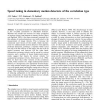Free Online Productivity Tools
i2Speak
i2Symbol
i2OCR
iTex2Img
iWeb2Print
iWeb2Shot
i2Type
iPdf2Split
iPdf2Merge
i2Bopomofo
i2Arabic
i2Style
i2Image
i2PDF
iLatex2Rtf
Sci2ools
94
Voted
BC
1999
1999
Speed tuning in elementary motion detectors of the correlation type
A prominent model of visual motion detection is the so-called correlation or Reichardt detector. Whereas this model can account for many properties of motion vision, from humans to insects (review, Borst and Egelhaaf 1989), it has been commonly assumed that this scheme of motion detection is not well suited to the measurement of image velocity. This is because the commonly used version of the model, which incorporates two unidirectional motion detectors with opposite preferred directions, produces a response which varies not only with the velocity of the image, but also with its spatial structure and contrast. On the other hand, information on image velocity can be crucial in various contexts, and a number of recent behavioural experiments suggest that insects do extract velocity for navigational purposes (review, Srinivasan et al. 1996). Here we show that other versions of the correlation model, which consists of a single unidirectional motion detector or incorporates two oppositely d...
| Added | 22 Dec 2010 |
| Updated | 22 Dec 2010 |
| Type | Journal |
| Year | 1999 |
| Where | BC |
| Authors | Johannes M. Zanker, M. V. Srinivasan, Martin Egelhaaf |
Comments (0)

